
분류 성능 평가
1. 정확도 점수 (Accuracy Score)
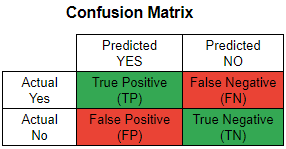
- 정확도는 모델에서 올바르게 예측한 점수로 다음과 같다.
- 정확도 = (TP + TN) / (TP + TN + FP + FN)

- yhat은 i 번째 예측 값이고, y는 실제 값이다.
- 따라서, yhat == y인 경우를 전체 경우로 나눈 경우이다.
기본 함수
from sklearn.metrics import accuracy_score
y_pred = [0, 2, 1, 3]
y_true = [0, 1, 2, 3]
accuracy_score(y_true, y_pred) <- 0.5임
accuracy_score(y_true, y_pred, normalize=False) <- 2임- normalize = False를 하면 같은 경우의 셈을 의미한다.
Numpy 구현
import numpy as np
def accuracy_score(y_pred, y_true):
yhat = np.array(y_pred)
y = np.array(y_true)
accuracy = np.mean(y == yhat)
return accuracy2. Top-k Accuracy Score
- 딥러닝 모델에서도 쓰이는 점수로 분류 모델에서 예측한 가장 가능성이 높은 N개의 클래스와 동일한 실제 클래스의 표준 정확도라고 할 수 있다.
- 예를 들어, 우리가 동물을 분류한다고 하자.
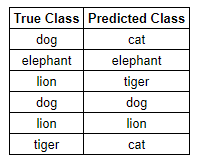
- 이 경우 우리는 50%의 정확도를 얻을 수 있다.
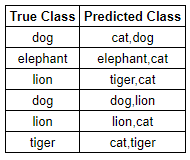
- 이 경우 각 예측값이 2개 이므로 83%의 정확도를 보여주고 있다.
- 이 처럼 정확도를 높이기 위해 예측 값의 개수를 늘리는 것을 Top-k 정확도라고 할 수 있다.

이 식을 보면서도 알 수 있는 것은 k개의 샘플을 일일이 대조하며 맞는 값을 찾으며 예측 정확도를 높이는 것이다.
기본 함수
import numpy as np
from sklearn.metrics import top_k_accuracy_score
y_true = np.array([0, 1, 2, 2])
y_score = np.array([[0.5, 0.2, 0.2],
[0.3, 0.4, 0.2],
[0.2, 0.4, 0.3],
[0.7, 0.2, 0.1]])
top_k_accuracy_score(y_true, y_score, k=2) <- 0.75임
top_k_accuracy_score(y_true, y_score, k=2, normalize=False) <- 3임직접 구현
def top_k_accuracy(X, y, k, classifier):
X_train, X_test, y_train, y_test = train_test_split(X, y, test_size=0.2)
# 자연어처리 시 문자를 넣어 단어 출현 횟수를 세는 함수이다.
vectorizer = TfidVectorizer(min_df=2)
X_train_sparse = vectorizer.fit_transform(X_train)
feature_names = vectorizer.get_feature_names()
test = vectorizer.transform(X_test)
clf = classifier
clf.fit(X_train_sparse, y_train)
predictions = clf.predict(test)
probs = clf.predict_proba(test)
# probs를 기준으로 정렬함
topk = np.argsort(probs, axis = 1)[:, -n:]
y_true = np.array(y_test)
return np.mean(np.array([1 if y_true[k] in topk[k] else 0 for k in range(len(topk))]))3. Balanced Accuracy Score
- 불균형 데이터 셋에서 과장된 성능 추정을 방지한다.
- 클래스당 재현율 점수의 매크로 평균이나 각 샘플이 실제 클래스의 역 보급에 따라 가중치가 부여되는 정확도라고 한다.
- 균형 잡힌 데이터 셋의 점수는 정확도와 같다.

- Binary 경우에 Sensitivity(true positive rate)와 specificity (true negative rate)의 산술 평균으로 나타낼 수 있다.
- 예를 들어, 1000개의 라벨이 2개의 종류로 있을 때, Class1이 750개, Class2가 250개 그리고 예측률이 740/750 = 98.7%, 240//250=96%이면 아래처럼 나타남을 알 수 있다.
Balanced_Accuracy_Score = (98.7%+96%)/2 = 97.35%

adjusted=True 의 경우 위에서 나타내는 1/nsamples이 1/(1- nsamples)로 불균형 데이터를 조정하려고 하는 것이 존재한다.
기본 함수
from sklearn.metrics import balanced_accuracy_score
y_true = [0, 1, 0, 0, 1, 0]
y_pred = [0, 1, 0, 0, 0, 1]
balanced_accuracy_score(y_true, y_pred)Tensorflow 구현
class BalancedSparseCategoricalAccuracy(keras.metrics.SparseCategoricalAccuracy):
def __init__(self, name='balanced_sparse_categorical_accuracy', dtype=None):
super().__init__(name, dtype=dtype)
def update_state(self, y_true, y_pred, sample_weight=None):
y_flat = y_true
if y_true.shape.ndims == y_pred.shape.ndims:
y_flat = tf.squeeze(y_flat, axis=[-1])
y_true_int = tf.cast(y_flat, tf.int32)
cls_counts = tf.math.bincount(y_true_int)
cls_counts = tf.math.reciprocal_no_nan(tf.cast(cls_counts, self.dtype))
weight = tf.gather(cls_counts, y_true_int)
return super().update_state(y_true, y_pred, sample_weight=weight)4. Confusion Matrix
- 분류 모델을 평가하는 지표를 [TP, TN, FP, FN] 4가지로 구분하여 행렬로 나타낼 수 있는 지표를 말한다.
- TP : 관심있는 지표를 정확하게 예측한 경우
- TN : 관심없는 지표를 정확하게 예측한 경우
- FP : 관심있는 지표를 잘못 예측한 경우
- FN : 관심없는 지표를 잘못 예측한 경우
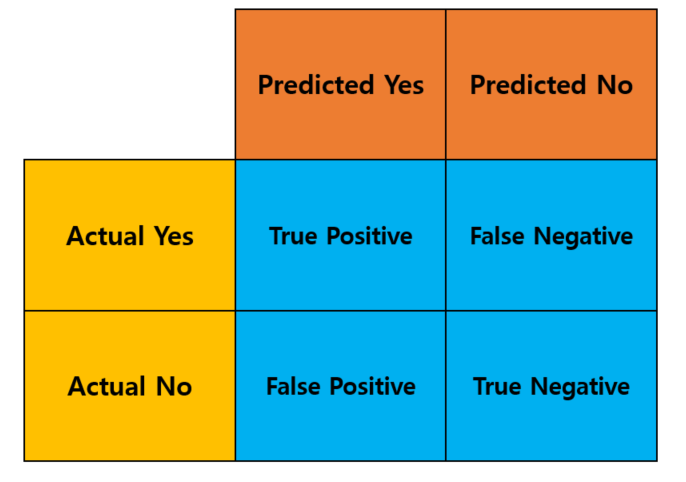
기본 함수
from sklearn.metrics import confusion_matrix
y_true = [2, 0, 2, 2, 0, 1]
y_pred = [0, 0, 2, 2, 0, 2]
confusion_matrix(y_true, y_pred)
출력
array([[2, 0, 0],
[0, 0, 1],
[1, 0, 2]])Numpy 구현
import numpy as np
def compute_confusion_matrix(true, pred):
# 고유값을 검색해 정렬함
K = len(np.unique(true))
# 고유값을 기준으로 KxK 행렬 생성
result = np.zeros((K, K))
for i in range(len(true)):
result[true[i]][pred[i]] += 1
return result5. Classification Report
classification_report는 분류 성능 평가에 필요한 지표를 text 형식의 Report로 지원해준다.
from sklearn.metrics import classification_report
y_true = [0, 1, 2, 2, 0]
y_pred = [0, 0, 2, 1, 0]
target_names = ['class 0', 'class 1', 'class 2']
print(classification_report(y_true, y_pred, target_names=target_names))
출력
precision recall f1-score support
class 0 0.67 1.00 0.80 2
class 1 0.00 0.00 0.00 1
class 2 1.00 0.50 0.67 2
accuracy 0.60 5
macro avg 0.56 0.50 0.49 5
weighted avg 0.67 0.60 0.59 56. Precision, recall
이진 분류 기업을 사용하는 곳에서 정밀도는 전체 예측 중에서 정확하게 예측한 비율이고, 재현율은 관련 있는 것들 중에서 실제 값들의 비율이다.
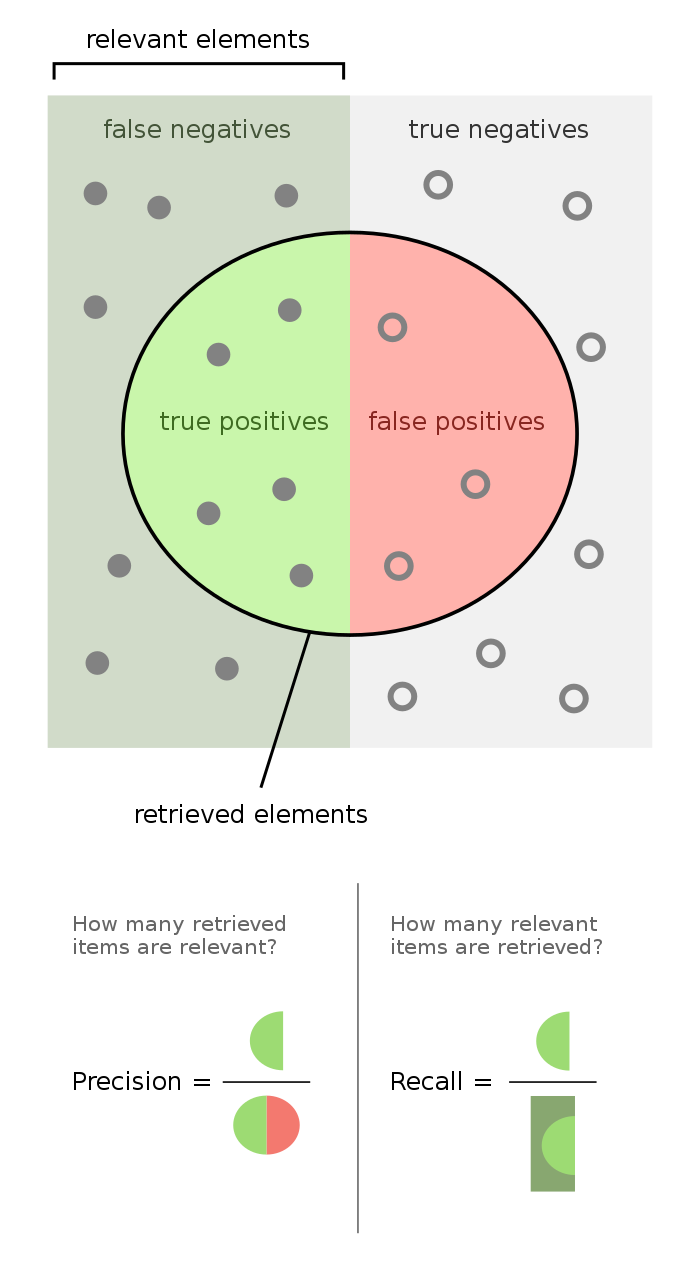
Precision, Recall 기본 함수
from sklearn.metrics import precision_score, recall_score
y_true = [0, 1, 2, 0, 1, 2]
y_pred = [0, 2, 1, 0, 0, 1]
precision_score(y_true, y_pred, average='macro')
recall_score(y_true, y_pred, average='weighted')
# average_precision_score 함수
import numpy as np
from sklearn.metrics import average_precision_score
y_true = np.array([0, 0, 1, 1])
y_scores = np.array([0.1, 0.4, 0.35, 0.8])
average_precision_score(y_true, y_scores)Precision, Recall을 Python으로 구현하기
Case1
def compute_average_precision_recall(precision_recall_dict):
precision = 0
recall = 0
for _, value in precision_recall_dict.items():
precision += value['precision']
recall += value['recall']
average_precision = safe_divide(precision, len(precision_recall_dict))
average_recall = safe_divide(recall, len(precision_recall_dict))
return average_precision, average_recallCase2 : Average_Precision
def compute_average_precision(precision, recall):
precision = np.concatenate([[0.0], precision, [0.0]])
for i in range(len(precision)-1, 0, -1):
precision[i-1] = np.maximum(precision[i-1], precision[i])
recall = np.concatenate([[0.0], recall, [1.0]])
changing_points = np.where(recall[1:] != recall[:1][0])
areas = (recall[changing_points + 1] - recall[changing_points]) * precision[changing_points + 1]
return areas.sum()7. F1-Score
F1-Score는 정밀도와 재현율의 조화평균으로 주로 분류 클래스 간 데이터가 심각한 불균형을 이루는 경우에 사용한다.

F1-Score는 여기서 베타 = 1인 경우로 보고 집어넣으면 된다.
기본 함수
from sklearn.metrics import f1_score
y_true = [0, 1, 2, 0, 1, 2]
y_pred = [0, 2, 1, 0, 0, 1]
f1_score(y_true, y_pred, average='macro')f1-score with Macro로 구현하기
def f1(actual, predicted, label):
tp = np.sum((actual==label) & (predicted==label))
fp = np.sum((actual!=label) & (predicted==label))
fn = np.sum((predicted!=label) & (actual==label))
precision = tp/(tp+fp)
recall = tp/(tp+fn)
f1 = 2 * (precision * recall) / (precision + recall)
return f1
def f1_macro(actual, predicted):
return np.mean([f1(actual, predicted, label)
for label in np.unique(actual)])8. ROC_CURVE 이해하기
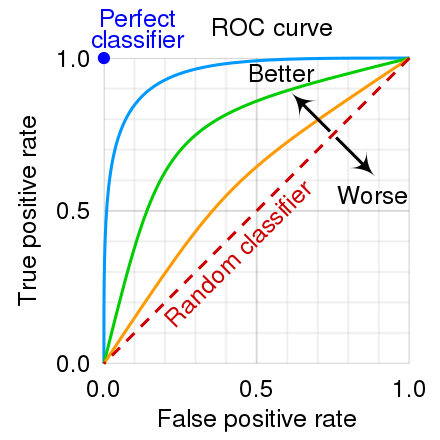
Roc_Curve를 보게 되면 X축은 FP, Y축은 TP로 얼마나 모델이 잘 분류를 하였는지 구분하며 Y축에 더 가까운 그래프를 형성할 수록 좋은 성능을 보인다고 말할 수 있다.
기본 함수
import numpy as np
from sklearn.metrics import roc_curve
y = np.array([1, 1, 2, 2])
scores = np.array([0.1, 0.4, 0.35, 0.8])
fpr, tpr, thresholds = roc_curve(y, scores, pos_label=2)- FP, TP, 분류기준을 알 수 있다.
